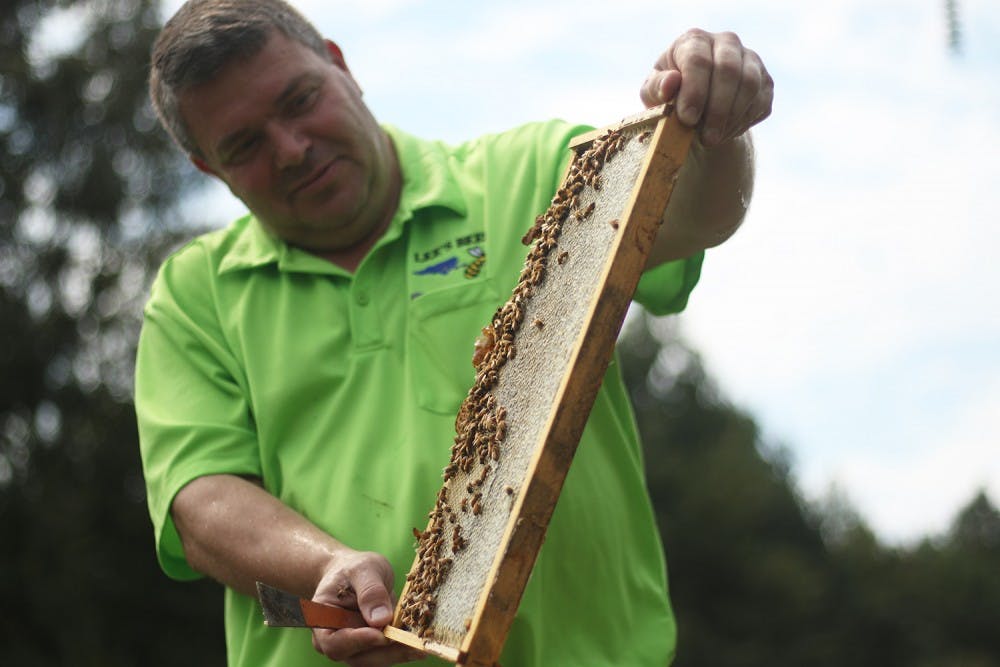“Farmers don’t have any real tangible ability to easily increase the wild bee population, and so they hedge their bets by renting honeybee colonies to provide that service,” Tarpy said.
The amount of transportation involved in commercial beekeeping led researchers at N.C. State to release the first study exploring the impact of long-distance travel on honeybee health, said Li-Byarlay, who co-authored the study with Tarpy among other researchers.
She said the research done at N.C. State found honeybees transported long distances showed signs of high stress and can live five percent shorter lives.
Lee said finding places with new flowers to feed his bees is growing more difficult due to growing housing and business developments.
“And even on some farms now, the farms will use every square inch of their dirt to plant a crop, and so there are no wildflowers or other native species that would bloom and actually provide nutrition for the bees,” he said.
Tarpy said the study’s findings showed variation in honeybees’ stress levels that can also be attributed to nutrition and other environmental factors.
Threats to the bees
Beyond malnutrition, bees encounter a number of other threats including parasites, pathogens and pesticides, Tarpy said.
On Aug. 28, South Carolina officials sprayed pesticides intended to combat the spread of the Zika virus and killed about 2.5 million bees in the process.
“Like in the case of this Zika spraying, what is really good at killing one insect like a mosquito tends to be really good at killing other beneficial insects like honeybees and these other native bees,” Tarpy said. “So, that’s always been this tradeoff in agriculture and human health.”
It is essential for officials and beekeepers to communicate so tragedies like this do not happen, he said.
Lee said it is difficult and expensive to keep bees alive, which is why there are less commercial beekeepers now than 40 years ago.
To get the day's news and headlines in your inbox each morning, sign up for our email newsletters.
“If I didn’t lose 40 percent of my bees every year, I would be doing well,” Lee said. “Just imagine losing 40 percent of your cattle or your pigs or your chickens every year.”
According to The White House, U.S. historical winter loss rates were only 10 to 15 percent.
The struggle of beekeepers
Tarpy said after beekeepers experience this degree of losses, they have to scramble to grow their colonies back.
“It’s that unsustainable fluctuation of die off, grow back, die off, grow back that’s really concerning, I think, to agriculture,” he said.
Lee received a doctorate in Organic Chemistry from Duke University, and said he has to use that knowledge to keep his bees alive — as if he were a bee veterinarian.
“Whereas just 25 or 30 years ago, it was hard to kill bees — they were very robust and vigorous — now, because of all these different factors, it’s a big challenge just to keep them healthy,” he said.
This year, Lee said he bought about 1,500 queen bees for total of nearly $30,000 and he must buy all of the supplements, multivitamins and medications for his bees.
“You’re sort of forced to be a commercial beekeeper if you’re actually looking at the economics of the industry,” Lee said. “You’re forced to move them just based on paying the bills.”
He said in order to be profitable, his bees need to participate in at least four different pollinations a year, which is why he has to ship them all over the country.
“Most of the death for me from the colonies comes in September and October,” Lee said. “So, I’m hoping it won’t be as bad, but I’m sort of expecting some.”
state@dailytarheel.com




